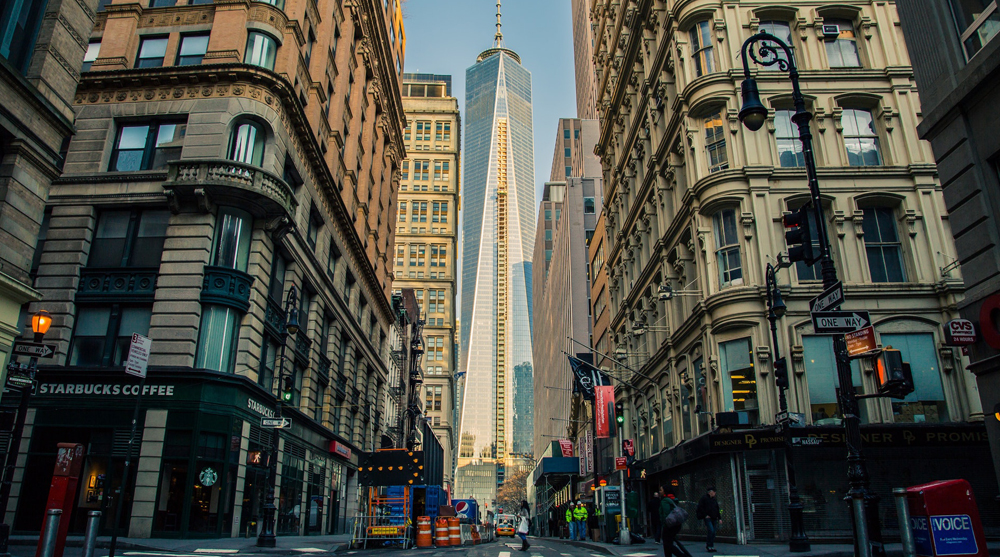The world’s urban population is growing steadily, and the United Nations has predicted that it will rise from 3.6 billion to 6.3 billion by 2050. Inevitably this will mean that buildings will need to accommodate more people while taking up less space. Meaning we’re likely to see skyscrapers growing in popularity as well as height.
Therefore, there will be more demand for skyscrapers to use new technology and innovative design to become more sustainable and have less of a negative impact on its environment.
1. Locally-sourced construction materials
The construction of skyscrapers has a significant impact on the environment, and using locally-sourced materials can reduce the impact during construction. The Bank of America Tower located near Times Square is one of New York’s tallest buildings, and was built with 40% locally-sourced materials as a way of cutting down energy usage and reducing emissions that would have been involved in transporting materials from further afield.

The Bank Of America Building in New York City was built with 40% locally-sourced materials to reduce the environmental impact of construction. Image source
2. Wind-resistant design
The higher a skyscraper reaches, the more resistant to strong winds it needs to be in order to be stable. The 632 meter-high Shanghai Tower is second only to Dubai’s Burj Khalifa when it comes to size, meaning it has to stand up against intensive weather at its highest point.
However, the curved spine of its design was ingeniously incorporated in order to redirect wind force, allowing for a less resource-intensive construction.
The Shanghai Tower employed wind-resistant design to lessen the need for extensive resources during construction. Image source
3. Green buildings (literally)
In an effort to become more green, there are certain skyscrapers that have taken the term literally, introducing green vegetation throughout the structure. Singapore’s Green Tower is due for completion in 2021 and will be an ideal example of green architecture, with lush vegetation strategically placed throughout to reduce the building's carbon footprint, while at the same time creating a more relaxing and soothing natural environment for residents.
The Oasia Hotel Downtown in Singapore is covered with green plants that absorb CO2 and provide a home for birds and animals in the heart of the city. Image source: By City-Reader - Own work, CC BY-SA 4.0
Singapore is also the home of Oasia Hotel Downtown, which is covered in 21 species of verdant climbers and flowers, creating a home for birds and animals within the heart of one of the world’s most built-up cities. In fact, it has an overall Green Plot Ratio of 1,100 percent, meaning there is 10 times as much greenery growing on a building than could have been on the same plot of unbuilt land. The tower’s open-sided gardens also reduce the need for mechanical ventilation.
4. Wind turbines
In addition to being resistant to high winds, skyscrapers have a unique opportunity to take advantage of them as a sustainable energy source. The Bahrain World Trade Center, built by multinational engineering company Atkins, includes stylish-yet-practical wind turbines in its design. The 240-meter high building on the small Middle Eastern island was inspired by traditional wind towers, and ensures that wind is directed to turbines attached to the building’s facade.
The Bahrain World Trade Center utilises wind turbines as both design aesthetic and renewable energy source. Image source
5. Temperature regulating façades
One of the biggest energy drains on skyscrapers is keeping the internal environment at a comfortable temperature, whether that includes heating in colder countries, or cooling in warmer environments. Air conditioners and central heating use considerable resources and create a larger carbon footprint for large buildings. Several new, more sustainable structures have used ingenious design to create façades that severely reduce the need for heating and cooling.
The Ping An International Finance Center reduces running costs and environmental impact with temperature-controlling façade design. Image source
The Ping An International Finance Center (IFC) in South China is the tallest building in the region, yet manages to run the skyscraper at 46% lower cost compared to conventionally-constructed commercial buildings. The IFC is LEED Gold certified thanks in part to a high-performance façade that minimises heat penetration while allowing maximum light to enter the offices. The structure also features external vertical stone fins that provide shading, thus reducing the demand for an internal cooling system.
The SKYHIVE Challenge
What is the future of skyscraper design? That’s up to you to decide. The SKYHIVE Challenge returns in 2019 for its second annual architecture competition to redefine the modern-day skyscraper. The jury will be looking for innovations in design, aesthetics, sustainability, and technology in order to create a structure that stands out amidst the world’s gleaming skylines.
Participants may select any location in any city around the world this competition. They are then tasked with creating designs for an iconic new high rise structure, one that not only pushes the boundaries of technology and design, but one that works to improve the city it will call home.
Top 3 Reasons Why You Should Enter Architecture Competitions
Curious about the value of architecture competitions? Discover the transformative power they can have on your career - from igniting creativity and turning designs into reality, to gaining international recognition.
Learn more



























